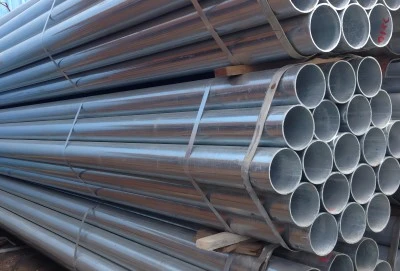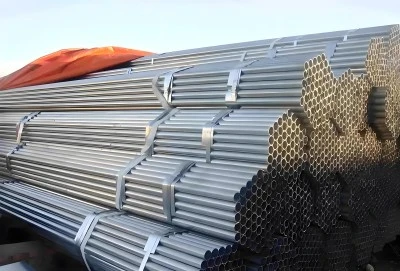General Lifespan
The longevity of zinc coated steel pipes, commonly referred to as galvanized pipes, is a topic of significant interest for engineers, contractors, and property owners alike. Understanding the expected lifespan of these pipes is crucial for planning, maintenance, and budgeting purposes. The durability of zinc-coated steel pipes can vary significantly depending on several factors, but generally, they are known for their impressive longevity.
Hot-dip zinc coated steel pipes are renowned for their durability and long-lasting performance. In favorable conditions, these pipes typically have a lifespan ranging from 30 to 50 years. This impressive longevity is primarily due to the thick, uniform zinc coating applied through the hot-dip galvanization process. According to a study published in the Journal of Materials Engineering and Performance, hot-dip galvanized pipes in non-corrosive environments have been known to last up to 70 years without significant deterioration.
On the other hand, electrogalvanized pipes generally have a shorter lifespan, typically ranging from 10 to 20 years. The primary reason for this reduced longevity is the thinner zinc coating applied through the electrogalvanization process. While still providing corrosion resistance, the thinner coating is more quickly depleted in corrosive environments. A report from the American Galvanizers Association indicates that the zinc coating on electrogalvanized pipes is typically 7-15 microns thick, compared to 45-200 microns for hot-dip galvanized pipes.
It's important to note that these lifespan estimates are general guidelines. In reality, the actual service life of zinc-coated steel pipes can vary significantly based on a multitude of factors, including environmental conditions, usage patterns, and maintenance practices.
|
|
|
Analysis Of Factors Affecting The Life Of Zinc Coated Steel Pipes
The longevity of zinc coated steel pipes is influenced by a complex interplay of various factors. Understanding these factors is crucial for predicting and potentially extending the lifespan of these pipes.
Environmental factors play a significant role in determining the lifespan of zinc-coated steel pipes. Humidity is a key factor, as high moisture levels can accelerate the corrosion process. According to research published in the Corrosion Science journal, a relative humidity above 60% can significantly increase the corrosion rate of zinc coatings. Temperature also plays a role, with higher temperatures generally accelerating corrosion processes. However, extremely low temperatures can cause their own issues, potentially leading to brittleness and cracking in some cases.
The acidity or alkalinity of the environment is another critical factor. Zinc coatings provide optimal protection in pH ranges between 6 and 12. Outside this range, the corrosion rate can increase dramatically. A study in the Materials and Corrosion journal found that the corrosion rate of zinc in highly acidic environments (pH < 4) can be up to 100 times faster than in neutral conditions.
Air pollutants, particularly sulfur dioxide and chlorides, can significantly impact the lifespan of zinc-coated pipes. These pollutants can react with the zinc coating, forming compounds that accelerate corrosion. Research from the International Journal of Corrosion shows that in industrial areas with high sulfur dioxide levels, the lifespan of galvanized pipes can be reduced by up to 40% compared to rural areas.
The quality of the galvanizing layer is another crucial factor. The thickness of the zinc coating directly correlates with the pipe's lifespan. According to standards set by ASTM International, the minimum coating thickness for hot-dip galvanized pipes ranges from 33 to 100 microns, depending on the pipe's thickness. Thicker coatings generally provide longer protection. The uniformity of the coating is equally important. Uneven coatings can lead to localized corrosion, significantly reducing the pipe's overall lifespan.
The usage environment of the pipes also plays a significant role in their longevity. Indoor environments are generally less corrosive than outdoor ones, owing to reduced exposure to moisture and pollutants. A study in the Journal of Construction and Building Materials found that galvanized pipes in indoor residential settings can last up to 20% longer than those in outdoor industrial environments.
For buried pipelines, soil corrosivity is a critical factor. Factors such as soil moisture, resistivity, and chemical composition can greatly influence the corrosion rate. The National Association of Corrosion Engineers (NACE) provides guidelines for assessing soil corrosivity, which can help in predicting the lifespan of buried galvanized pipes.
Methods To Extend Service Life Of Zinc Coated Steel Pipes
While zinc coated steel pipes are inherently durable, there are several strategies that can be employed to further extend their service life. These methods focus on proper selection, installation, and additional protection measures.
Choosing the right zinc-coated steel pipe for the specific application and environment is crucial. For harsh environments or applications requiring extended longevity, pipes with thicker galvanizing layers should be selected. The American Galvanizers Association recommends using pipes with coating weights of at least 2.0 oz/ft² (610 g/m²) for severe environments. Additionally, considering the specific type of zinc coating can make a significant difference. For instance, in highly acidic or alkaline environments, pipes with zinc-5% aluminum-mischmetal alloy coatings have shown superior corrosion resistance compared to traditional zinc coatings.
Correct installation practices are vital for maximizing the lifespan of zinc-coated steel pipes. Care should be taken to avoid damaging the zinc coating during handling and installation. The Galvanizers Association of Australia recommends using nylon slings or padded clamps when handling galvanized pipes to prevent coating damage. Any damage to the coating should be promptly repaired using zinc-rich paints or cold galvanizing compounds to prevent localized corrosion.
In particularly challenging environments, applying an additional protective layer can significantly extend the pipe's lifespan. Epoxy coatings, for example, can provide an extra barrier against corrosive elements. A study published in the Progress in Organic Coatings journal found that epoxy-coated galvanized steel showed 70% less corrosion than uncoated galvanized steel after 2000 hours in a salt spray test. For underground applications, cathodic protection systems can be employed to further protect the pipes from soil-based corrosion.
Regular maintenance and inspection are also key to extending the life of zinc coated steel pipe. Periodic cleaning to remove dirt and contaminants can prevent accelerated corrosion. In industrial settings, where pipes may be exposed to chemical splashes or aggressive atmospheres, more frequent cleaning and inspection may be necessary. The frequency of these maintenance activities should be based on the specific environmental conditions and usage patterns.
Zinc Coated Steel Pipe Manufacturer
When considering zinc-coated steel pipes for your project, choosing a reputable manufacturer is crucial to ensure the quality and longevity of the pipes. LONGMA GROUP is a notable manufacturer in this field, producing zinc-coated steel pipes that comply with several international standards, including API 5L, ASTM A53, EN10210, and AS/NZS 1163.
API 5L, developed by the American Petroleum Institute, sets stringent requirements for line pipes used in the oil and gas industry. This standard ensures that the pipes meet specific criteria for strength, dimensions, and coating quality, which are crucial for the demanding environments in which these pipes are often used.
ASTM A53, established by the American Society for Testing and Materials, covers both black and hot-dipped zinc-coated welded and seamless steel pipe. This standard is widely recognized and ensures that the pipes meet specific requirements for chemical composition, mechanical properties, and coating thickness.
EN10210 is a European standard that specifies the technical delivery conditions for hot finished structural hollow sections of non-alloy and fine grain steels. This standard is particularly relevant for construction and engineering applications in the European market.
AS/NZS 1163 is a joint Australian and New Zealand standard that sets specifications for structural steel hollow sections. This standard ensures that the pipes meet the specific requirements of these markets, which can be particularly important for projects in Oceania.
By adhering to these diverse international standards, LONGMA GROUP demonstrates its commitment to producing high-quality zinc-coated steel pipes suitable for a wide range of applications and environments. This compliance can provide assurance to buyers about the expected performance and longevity of the pipes.
For those considering zinc coated steel pipes for their projects and seeking more information about the expected lifespan in specific applications or environments, LONGMA GROUP offers direct consultation. Interested parties can reach out to them at info@longma-group.com to discuss specific requirements, learn about their product specifications, or inquire about best practices for maximizing the lifespan of their zinc-coated steel pipes in various environments.














